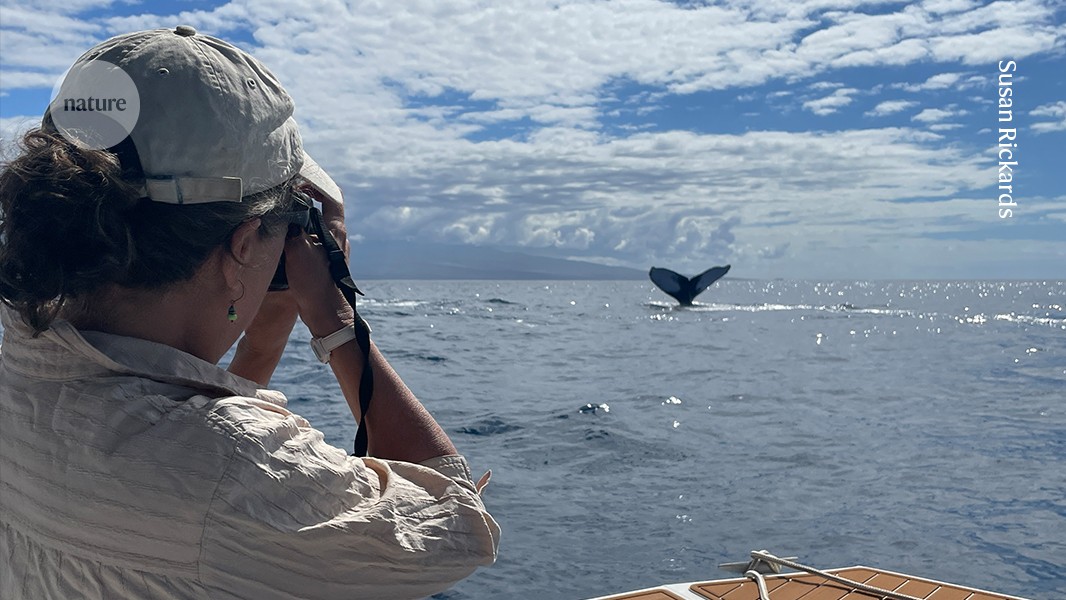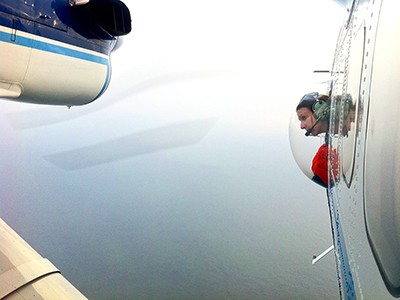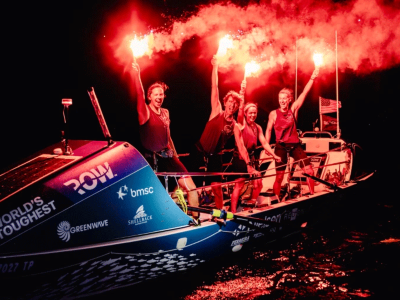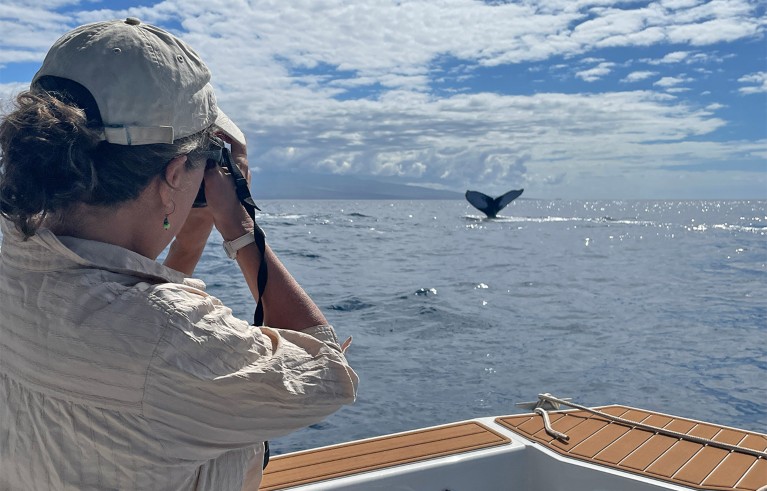
Christine Gabriele spotting the tail fluke of a humpback whale in Hawaiian waters. Her career has followed the whales’ migration back and forth from their tropical breeding grounds in Hawaii in winter to summer feeding areas in Alaska.Credit: Susan Rickards, taken under NOAA Fisheries scientific research permit 26596
Leaving Kawaihae harbour in Hawaii at 7.42 a.m. on a bright sunny morning in March, the volunteer crew of the Sealegs, an amphibious boat, passes some brown boobies (Sula leucogaster) on a buoy. “We call them Barbie Booby and Bobby Booby,” smiles Christine Gabriele, noting that after frequent sightings decades earlier, the seabirds had disappeared from here, returning only in 2021. “Something must’ve changed,” she says, noting that ocean life still holds so many mysteries. Unravelling some of them, by tracking long-term changes through careful monitoring of marine mammals, has been a focus of her work.
Gabriele’s eyes are keenly focused on the azure waters ahead. “Sorry for not making eye contact. I’m always scanning, scanning, scanning,” she says, referring to the search for humpback whales (Megaptera novaeangliae). Spotting tails and fins is more challenging than usual this morning. Strong winds overnight have not entirely calmed. Windy spells are common along this northernmost peninsula of Hawaii’s Big island. Inside Gabriele’s house on the hillside a few kilometres above, every door has wall hooks to prevent slamming by sudden gusts. “Your hat might blow off today,” warns Gabriele’s colleague Suzanne Yin, as we motor away from shore.
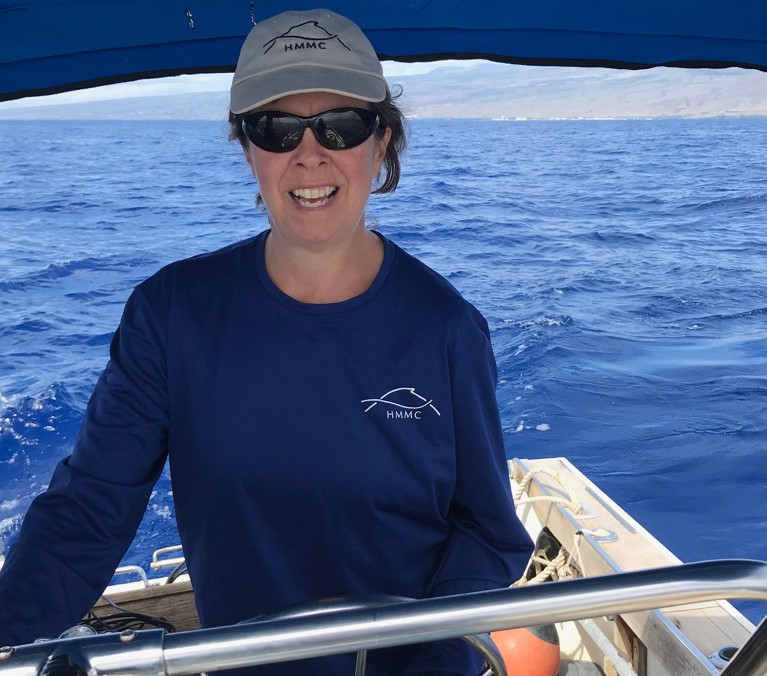
Marine biologist Christine Gabriele’s work has documented the whales’ lifespan, reproductive biology, vocalizations and response to a devastating marine heatwave, among other topics.Credit: Suzanne Yin
Yin explains that when drawing attention to whales, “we try to use the vessel as a clock”. I’m instructed that if I see a whale, I’m not to point and shout “over there”, but rather to declare “Whale at 12 o’clock”, for example, to indicate one straight ahead.
Just 20 minutes into the trip, a misty plume rises from a whale’s blowhole. “Whale up,” says Gabriele, snapping photographs of the underside of its fluke, as the creature’s two-lobed tail is called, with her telephoto lens.
It is the first of many whale observations on this seven-hour monitoring trip. A few hours later, the volunteer crew lowers a hydrophone into the water to eavesdrop on humpbacks nearby. Against the background static of snapping shrimp come the haunting, rising and descending songs of several whales in concert. The calls sound like ghostly oooohs and creaky-door squeaks. Systematic recording of whale song is one way in which Gabriele’s team monitors local whale abundance. A few minutes later, a school of 50 or more spinner dolphins (Stenella longirostris) swims by, some pirouetting as they porpoise in and out of the water.
The pull of the sea
“I’ve always loved the ocean,” Gabriele says. Growing up in upstate New York, she developed a fascination for marine mammals early on, and her interest was fuelled by family seaside holidays. As an undergraduate at Cornell University in Ithaca, New York, she studied biology and animal behaviour. An undergraduate semester at sea on a schooner travelling from Massachusetts to the West Indies solidified her love for marine biology.
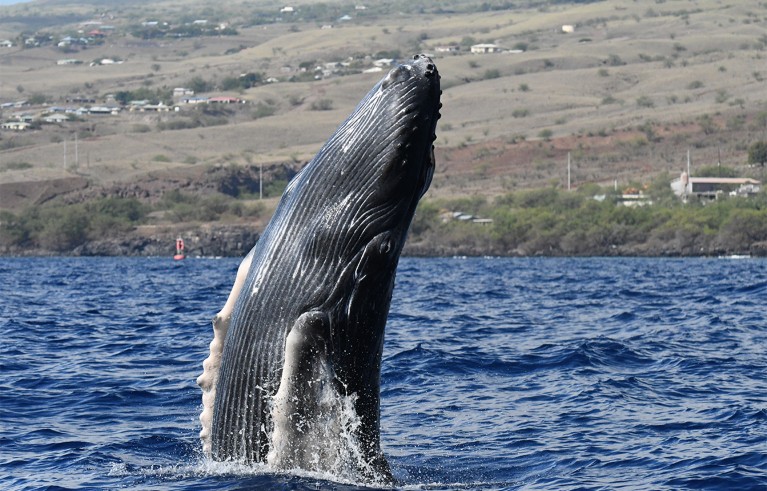
A humpback whale calf breaches off Kawaihae harbour, Hawaii Island.Credit: Christine Gabriele, taken under NOAA Fisheries scientific research permit 26596
After her undergraduate degree, Gabriele worked in an auditory biology lab in Boston, Massachusetts. “I loved the job. But it cemented for me that I wanted to work outdoors,” says Gabriele. So she applied for graduate courses and landed a place on a master’s programme at the University of Hawaii at Manoa in Honolulu, studying the reproductive behaviour and Hawaiian residence time of humpback whales.
She graduated in 1992, and afterwards a colleague who had initiated a whale-monitoring programme in the Glacier Bay region of Alaska moved to New Zealand, creating a vacancy. Gabriele applied for and secured the job, which was with the National Park Service in Gustavus, Alaska. She has spent much of the past 34 years as a wildlife biologist studying the humpbacks that spend May to October feeding in the nearby Glacier Bay National Park. However, as someone determined to have a year-round understanding of their biology, she found a way for her career to mirror their migratory patterns.
Flying low and slow over endangered whales
During her graduate studies in Hawaii, Gabriele never saw a feeding humpback whale, she says. North Pacific humpbacks feed little, if at all, while in Hawaiian waters, which are their main winter breeding grounds. Each winter and spring, thousands of whales — about half of all humpbacks swimming in the North Pacific, not just those from Alaska — visit these warm waters to breed and birth and nurse their young.
So Gabriele spends spring, summer and autumn studying humpbacks in Glacier Bay. Then, like the humpbacks, she winters in Hawaii, volunteering for two and a half months each year for the Hawaii Marine Mammal Consortium (HMMC), a non-profit organization that she co-founded in 2001. Hawaiian monitoring work proceeds while she analyses data and publishes research from her full-time Alaskan work.
“Very few researchers who study humpback whales study them in both of their habitats,” says Gabriele. “I’m really glad to be one of those.”
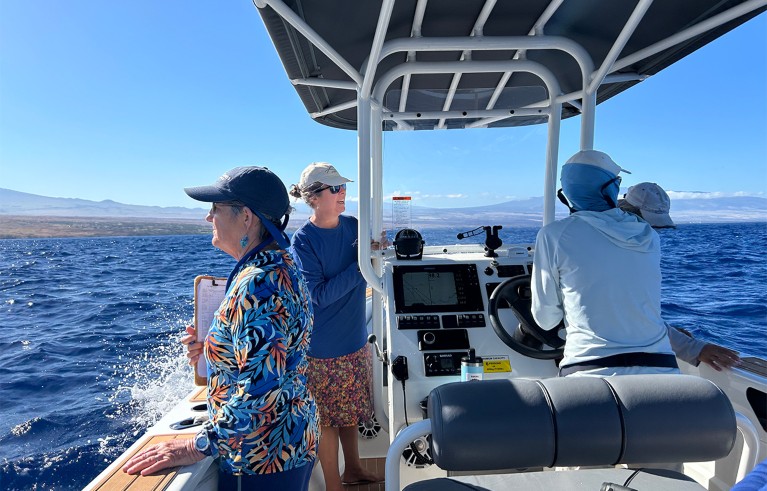
Members of the Hawaii Marine Mammal Consortium (HMMC) Holly Sargeant-Green, Christine Gabriele, Susan Rickards and Suzanne Yin (left to right) conduct research off the Kohala Coast of Hawaii Island.Credit: Lesley Evans Ogden, courtesy of Hawaii Marine Mammal Consortium
The HMMC runs on a shoestring, and its boat was contributed by an anonymous donor. “We run on a lot of blood, sweat and tears,” says volunteer researcher Susan Rickards, an HMMC board member and school science teacher. Co-founder Adam Frankel is a bioacoustics consultant and Yin does ship-board observing of marine mammal populations.
Routine’s rich rewards
In both Alaska and Hawaii, “what we do tends to be fairly routine, simple, repeated research”, says Gabriele. “That has a lot of power, because we can detect change over time.” Over the years, she has investigated a wide range of questions in humpback biology, such as links between ocean temperatures and population trends. She helped to document the impacts of a marine heatwave11 from late 2013 to 2016 that led to a crash in the humpback population in Hawaii and Alaska2. In Alaska, she has also contributed to citizen-science and marine pilot-training programmes to mitigate the risk of whales being struck by ships.
Much of her population work relies on photos of whale-tail markings to identify individuals. Since 2015, a machine-learning image-recognition algorithm known as Happywhale, pioneered by marine ecologist Ted Cheeseman at Southern Cross University in Lismore, Australia, has revolutionized humpback-whale identification. Gabriele is one of about 70 researchers who contributed photographic data to train this AI application, making individual identification faster and easier.
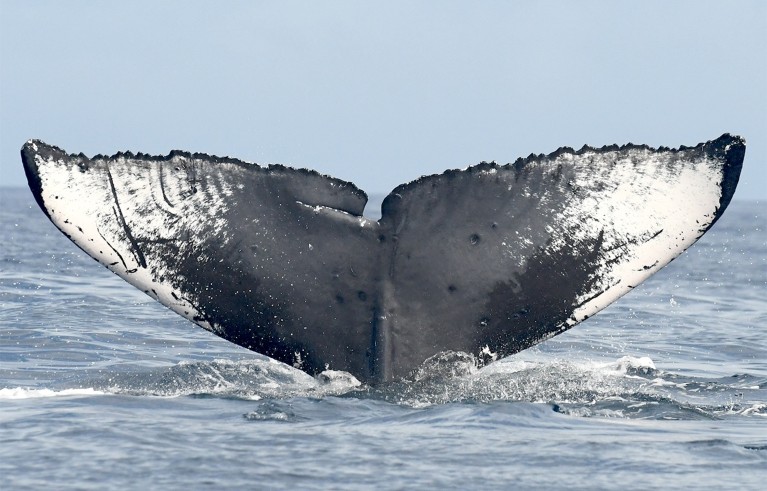
Credit: Christine Gabriele, taken under NOAA Fisheries scientific research permit 26596
Gabriele is “a great collaborator”, says Jan Straley, a marine biologist at the University of Alaska Southeast in Juneau who says it was a whale that ‘introduced’ them. Decades ago, a whale that Straley had photographed off the coast of southeast Alaska was spotted by Gabriele off Hawaii’s Big Island a little over a month later, and the photographic database of whale tails, geographical locations and observer names enabled the two to compare notes. Straley became a mentor to Gabriele as she embarked on work in Alaska. The two have since collaborated on many projects, including a database of whale sounds.
Easy-going, calm and level-headed even in gnarly sea conditions, Gabriele “has your back”, says Straley. HMMC volunteer Holly Sargeant-Green agrees. “She doesn’t get rattled easily.” Sargeant-Green recounts how, when out on the water off Hawaii, Gabriele sometimes instantly identifies whales that she studies in Alaska from their flukes, with no AI required. “That’s pretty extraordinary,” she says.
Racing across the Atlantic: how we pulled together for ocean science
Conservation researcher Jo Marie Acebes saw this talent on the Alaskan side of the Pacific, noting that Gabriele “knew every single humpback whale we encountered just by looking at the dorsal fin or fluke”. Acebes, a long-time international collaborator of Gabriele, founded the non-profit organization Balyena.org based in Bohol, the Philippines, and is a senior researcher in the zoology division of the National Museum of the Philippines in Manila. After working remotely with Gabriele for years, Acebes fulfilled a lifelong dream of travelling to Glacier Bay National Park in 2022. Gabriele “is truly one of those scientists that have made great contributions to what we now know about humpback whales”, says Acebes. For example, Gabriele has tracked humpback pregnancy rates using hormone analyses4,3, and has documented how ship noise influences whale communication5.
“It is not easy being a whale in today’s oceans,” says Gabriele, noting that one of the main aims of her research exploring their beguiling biology and behaviour is to work out how to decrease human impacts. “I feel very lucky to be a migratory biologist. I work in two of the most beautiful places on Earth. It’s such a privilege.”


